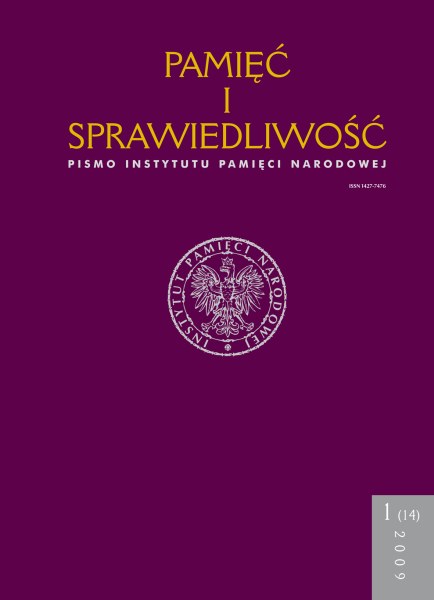Lwowski sobór 8–10 marca 1946 roku: przygotowania, przebieg i skutki. Rola systemu totalitarnego
Pamięć i Sprawiedliwość, Tom 14 Nr 1 (2009), strony: 237-267
Data publikacji: 2009-12-30
Abstrakt
After the liberation of the western Ukraine from the occupation of the Third Reich, Stalin’s Communist regime has launched a broad attack on Catholicism, especially on its factions, as the Roman Catholic Church, the Armenian Catholic Church and the Ukrainian Greek Catholic Church, which dominated the religious
life in Lviv, Stanislavsky, Drogobych and Ternopil regions.
RCC (Roman Catholic Church), in particular, has reduced its presence tenfold (from more than 400 parishes in Lviv Archdiocese in 1944 to less than forty – in the late 1946, through the deportation of Poles from Ukraine and Ukrainians from Poland in 1944–1946) in the region. ACC, as an institution, was completely annihilated by the Bolshevik regime in 1945, by the so-called attempted revival of free Armenia.
UGCC (Ukrainian Greek Catholic Church), which included about 2300 religious communities, and which had great infl uence on public life of the Ukrainian western regions, formed their patriotic consciousness, and therefore did not fi t in the Bolshevik plan of “sovietization” of the Ukrainian population in the mentioned areas.
Therefore the NKVD (People Commissariat for Internal Affairs) and the Bolshevik party elite decided to eliminate UGCC as an institution.
The Council for Russian Orthodox Church in Sovnarcom Soviet Union and the Council for worship at Sovnarcom USSR developed a plan for the acquisition of parishes by the Russian Orthodox Church. This plan included: the elimination of monasteries, repression of the hierarchy, clergy, monks, which would prevent the so-called reunifi cation of UGCC with ROC. In May 1945, especially for this last point, the so-called Initiative Group was established (with the direct assistance of the NKVD and referred to as the Soviets). It was led by some leaders of the
Greek Catholic priests, who had subsequently carried out this reuniting action. This group has been actively promoted by the local provincial councils, authorized for ROC and for religious worship, as well as functionaries of the provincial offices of the NKVD and Orthodox bishops. In October 1945, as a result of the abovementioned joint actions of these institutions, nearly 800 priests of 1259 – agreed to the reunifi cation.
The danger of arrest, deportation of families to Siberia, prison by the NKVD of the Church hierarchy, together with Metropolitan Joseph Slipy and others – these were the reasons, which forced the majority of the Church to reunite. However, the Greek Catholic parishes did not feel such dangers, therefore only 9 of the 2286
religious communities passed to ROC till the end of 1945, so the community waited. To put the fag end in the annihilation of UGCC (Ukrainian Greek Catholic Church), the leadership of the Union of the above-mentioned Councils decided to organise the Assembly, which should be prepared by the Initiative Group, pro-orthodox reunited clergy and the Moscow Patriarchate. The assembly took place in Lviv, March 8–10, 1946, in St. George church and took the following decisions: to annul the decision of the Union of Brest in 1596, return to orthodoxy, reunite with the Russian Orthodox Church Moscow Patriarchate. These decisions-appeals were approved by Moscow Patriarch Aleksij . Greek Catholic historiography, based on the then USSR and USRR law considers this Assembly as non-canonical, because
it was not appointed by the Church hierarchy, the church delegates have not been elected by the Greek-Catholic clergy, and the bishop of the Church did not participate in this Assembly, that is why the Assembly had no right to take the above decision. More than 400 priests of the „white” and „black” clergy, who did
not agree with the decision of the Assembly and who still continued to practice the Greek-Catholic religious tradition, were arrested over the next four years and condemned by the NKVD executives.
The Totalitarian regime begun to attack the Greek-Catholic monastery on the pretext of the so-called compression, as a result, in 1950, only a few male and female monasteries remained in force.
Thanks to the efforts of the “authorized regional councils”, the Greek-Catholic religious communities slowly began to move into the structure of ROC. Over several years, some communities had the possibilities to avoid the reunion with ROC, as they were under the church care by hundreds of UGCC priests, so they
were able to escape from prison and go underground. But the totalitarian government would put forward the struggle with the Greek Catholic Church in order to “cleanse” the western region of Ukraine and establish there the obedience to the Russian Orthodoxy.
Inne teksty tego samego autora
- Jarosław Stocki, Kościół rzymskokatolicki na Ukrainie Zachodniej na przykładzie Tarnopolszczyzny w latach 1946–1989 , Pamięć i Sprawiedliwość: Tom 7 Nr 1 (2005)
 Język Polski
Język Polski
 English
English
 Deutsch
Deutsch
 Français (France)
Français (France)
 Italiano
Italiano
 Русский
Русский


 PDF
PDF
